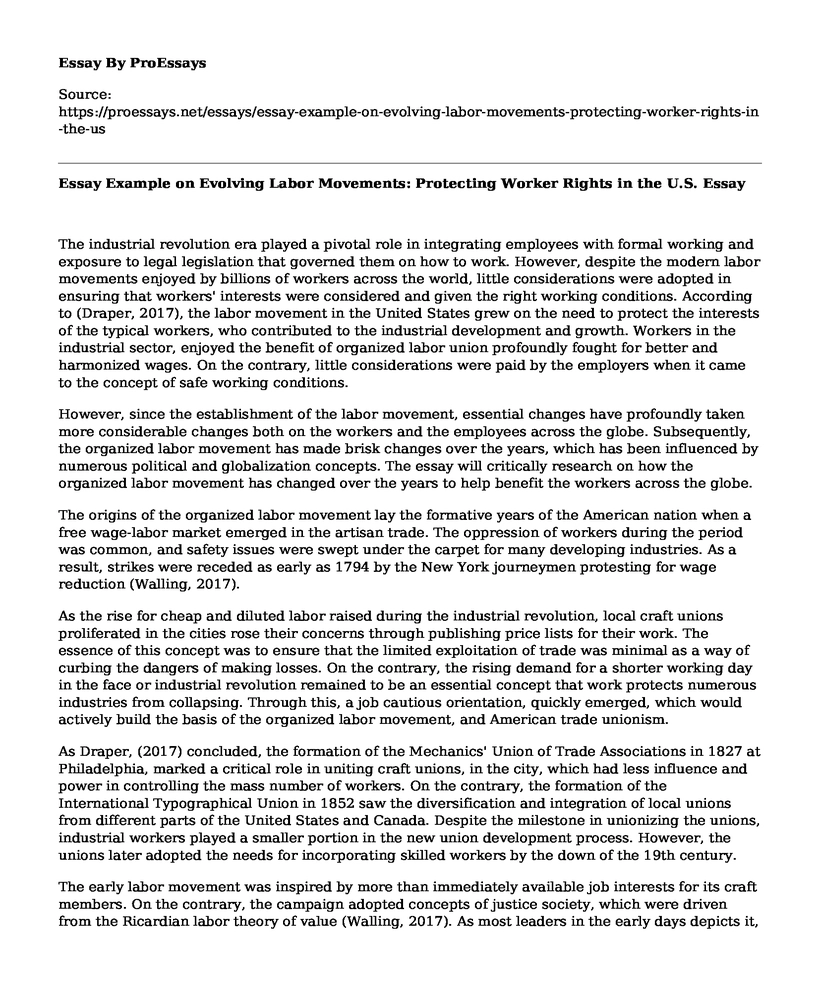The industrial revolution era played a pivotal role in integrating employees with formal working and exposure to legal legislation that governed them on how to work. However, despite the modern labor movements enjoyed by billions of workers across the world, little considerations were adopted in ensuring that workers' interests were considered and given the right working conditions. According to (Draper, 2017), the labor movement in the United States grew on the need to protect the interests of the typical workers, who contributed to the industrial development and growth. Workers in the industrial sector, enjoyed the benefit of organized labor union profoundly fought for better and harmonized wages. On the contrary, little considerations were paid by the employers when it came to the concept of safe working conditions.
However, since the establishment of the labor movement, essential changes have profoundly taken more considerable changes both on the workers and the employees across the globe. Subsequently, the organized labor movement has made brisk changes over the years, which has been influenced by numerous political and globalization concepts. The essay will critically research on how the organized labor movement has changed over the years to help benefit the workers across the globe.
The origins of the organized labor movement lay the formative years of the American nation when a free wage-labor market emerged in the artisan trade. The oppression of workers during the period was common, and safety issues were swept under the carpet for many developing industries. As a result, strikes were receded as early as 1794 by the New York journeymen protesting for wage reduction (Walling, 2017).
As the rise for cheap and diluted labor raised during the industrial revolution, local craft unions proliferated in the cities rose their concerns through publishing price lists for their work. The essence of this concept was to ensure that the limited exploitation of trade was minimal as a way of curbing the dangers of making losses. On the contrary, the rising demand for a shorter working day in the face or industrial revolution remained to be an essential concept that work protects numerous industries from collapsing. Through this, a job cautious orientation, quickly emerged, which would actively build the basis of the organized labor movement, and American trade unionism.
As Draper, (2017) concluded, the formation of the Mechanics' Union of Trade Associations in 1827 at Philadelphia, marked a critical role in uniting craft unions, in the city, which had less influence and power in controlling the mass number of workers. On the contrary, the formation of the International Typographical Union in 1852 saw the diversification and integration of local unions from different parts of the United States and Canada. Despite the milestone in unionizing the unions, industrial workers played a smaller portion in the new union development process. However, the unions later adopted the needs for incorporating skilled workers by the down of the 19th century.
The early labor movement was inspired by more than immediately available job interests for its craft members. On the contrary, the campaign adopted concepts of justice society, which were driven from the Ricardian labor theory of value (Walling, 2017). As most leaders in the early days depicts it, the first labor leaders saw it as rising to unite the two distinct classes between the rich and the impoverished. The 1830 Workingmen's party union began the early advocacy on the need for harmonizing wages and working conditions for the poor.
As technological changes swept the industrial revolution in the US, changes begun undermining the crafting system, that had been established over a century ago were becoming more visible. As the adoption of skills became a paramount point of concern, many unions did move on towards the sizeable industrial structure. However, skills acquisition paved the way for racial discrimination in the mid-1930s, since skills lined with sexist and racial discrimination, hence dissolving many unions from the international coalition.
References
Draper, A. (2017). Organized Labor and the Civil Rights Movement. In Oxford Research Encyclopedia of American History.
Walling, W. (2017). American labor and American democracy. Routledge.
Cite this page
Essay Example on Evolving Labor Movements: Protecting Worker Rights in the U.S.. (2023, Mar 26). Retrieved from https://proessays.net/essays/essay-example-on-evolving-labor-movements-protecting-worker-rights-in-the-us
If you are the original author of this essay and no longer wish to have it published on the ProEssays website, please click below to request its removal:
- Communications and Emotional Intelligence Essay
- The Texas Revolution Essay Example
- Racial Classification Paper Example
- Sweatshops as One of the Main Unethical Practices by Global Businesses - Essay Sample
- Essay Sample on Racial Sensitivity: America vs. Other Nations
- Essay Sample on Uniting Canada: Notable Leaders During the Confederation
- Essay Sample on Childish Gambino's This is America: A Commentary on American Society







